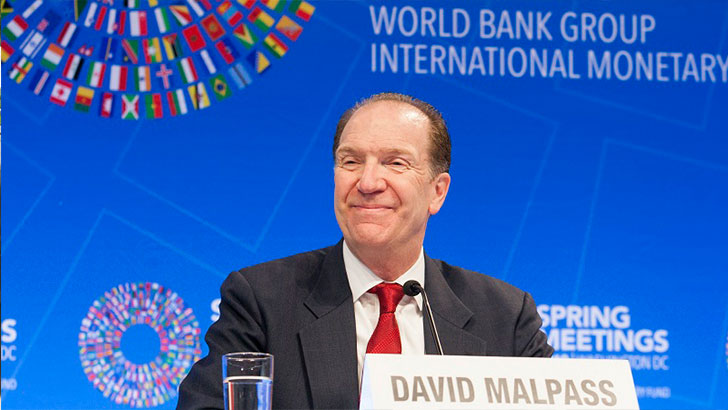World bank warns on debt
The World Bank Group has cautioned low income countries, including Malawi, against continued heavy borrowing in the hope that their external loans will be forgiven.
Instead, the bank has urged the poor countries to chart a gradual path towards consolidated economies.
In his address during a virtual conference on Growth in a Time of Crisis: What’s Ahead for Developing Economies on October 15 2021, World Bank Group president David Malpass said countries need stronger focus on key priorities on poverty alleviation. He said they can no longer keep on piling public debts.
He said: “Countries also need to lay the ground work for medium-long term growth for economic stability.
“Time has come to start charting a gradual path towards consolidation, one that keeps the welfare of citizens as the guiding principle, enhancing and simplifying tax structures while eliminating wasteful public expenditures.”

ground work
Malpass’ remarks come at a time Malawi’s public debt is staggering at K4.76 trillion with Minister of Finance Felix Mlusu begging the international community for debt cancellation.
Malawi’s external debt soared from $2.42 billion (about K1.97 trillion) to $2.94 billion (about K2.39 trillion) in 2020, according to the World Bank.
Speaking during the same meeting, the minister, who represented low income countries, said there is need for debt relief because main barriers to economic growth include unsustainable high levels of debt.
Mlusu said: “Barriers to economic growth are obviously many, starting with limited fiscal space. For [poor] countries to fund their development programmes, they are limited by financial resources.
“The other barrier is unsustainable high levels of debt which they have contracted over the last couple of years, and they cannot finance their programmes.”
The minister was reiterating the position President Lazarus Chakwera told the United Nations General Assembly in September that “to help us poor nations recover from the economic devastation caused by this pandemic, the starting point is three words: Cancel The Debts”.
At K4.76 trillion, public debt accounts for about 54 percent of Malawi’s gross domestic product (GDP).
The amount is down from 65 percent of GDP in June 2020, thanks to the GDP rebasing exercise that essentially propped up the value of Malawi’s nominal GDP from around $8.5 billion to $10.9 billion.
In his address, Malpass stressed that countries need stronger focus on key priorities on poverty alleviation instead of piling public debts.
He said acceleration of Covid-19 vaccinations and eliminating wasteful public expenditure were key to long-term economic growth.
The conference discussed, among others, how countries can build back better while simultaneously investing in their people, what types of policies can support inclusive growth, and what role central banks can play in helping spur job creation and investment.
The challenge Malawi faces, according to Catholic University of Malawi (Cunima) head of economics Hopkins Kawaye, is that most of the money it borrowed was not used for the intended purpose.
He said: “We have not used that money prudently. The K4.76 trillion debt is almost equivalent to three national budgets, but look at the development on the ground. The money and the development do not match. This is due to a number of reasons.
“We have high levels of corruption, and there is high misappropriation of funds, which keeps on crippling the economy and makes the fiscal policy that government is implementing not to be effective.”
Based on figures from Treasury and the International Monetary Fund (IMF), public debt is projected to grow to 78.2 percent of GDP by close of 2021 before climbing further to 81.3 percent of GDP in 2022 and 83 percent as well as 83.8 percent in 2023 and 2024, respectively.
The figures also show that Malawi has in the past 10 years spent over K123 billion on debt servicing and that is required to cover the repayment of interest and principal on debt for the period.
As at now, Malawi’s public debt has climbed to 69 percent of the country’s national output as measured by GDP.
Alarmed at the public debt levels it inherited and worried about the projected upward trend in the medium-term, the Chakwera administration is now pushing for a four-pronged strategy to bring down the crippling loans to manageable levels.
Treasury is on record as having said that the President last month approved a plan that includes returning to multilateral and bilateral creditors to negotiate debt relief.
The strategy will also be built around public expenditure efficiency and broadening external resource mobilisation to complement local efforts.
Further, the plan hinges on boosting domestic revenue through the Malawi Revenue Authority tax collection efforts as well as fees and levies from ministries, departments and agencies.
With deep-rooted structural constraints around public finance management in general, fiscal imbalances and the structure of the rain-fed agricultural economy that have made it hard for Malawi to control its public debt for decades, the fresh plan will need strong decisive leadership to work.
In the 2021/22 National Budget Statement, Mlusu indicated that government was struggling to repay the huge public debt stock and reached out to the donor community for budget support and debt restructuring.
The minister also said the ministry would establish the Debt Retirement Fund to retire the debt.
In an earlier interview, Malawi University of Business and Applied Sciences associate professor of economics Betchani Tchereni admitted that government needs to guard the debt which he said has become dangerous for the macroeconomic environment.
He said: “While efforts to curb inflation are underway from the monetary authorities, it is important that the fiscal angle of the economic cluster needs to do its part too. For sure we need to be sure about how we will pay off these loans really.”
Malawi’s public debt has increased rapidly since the country got a relief of its external debt in 2006, when 90 percent or $2.6 billion of its $3 billion foreign debt was written off under the Highly Indebted Poor Countries initiative.





